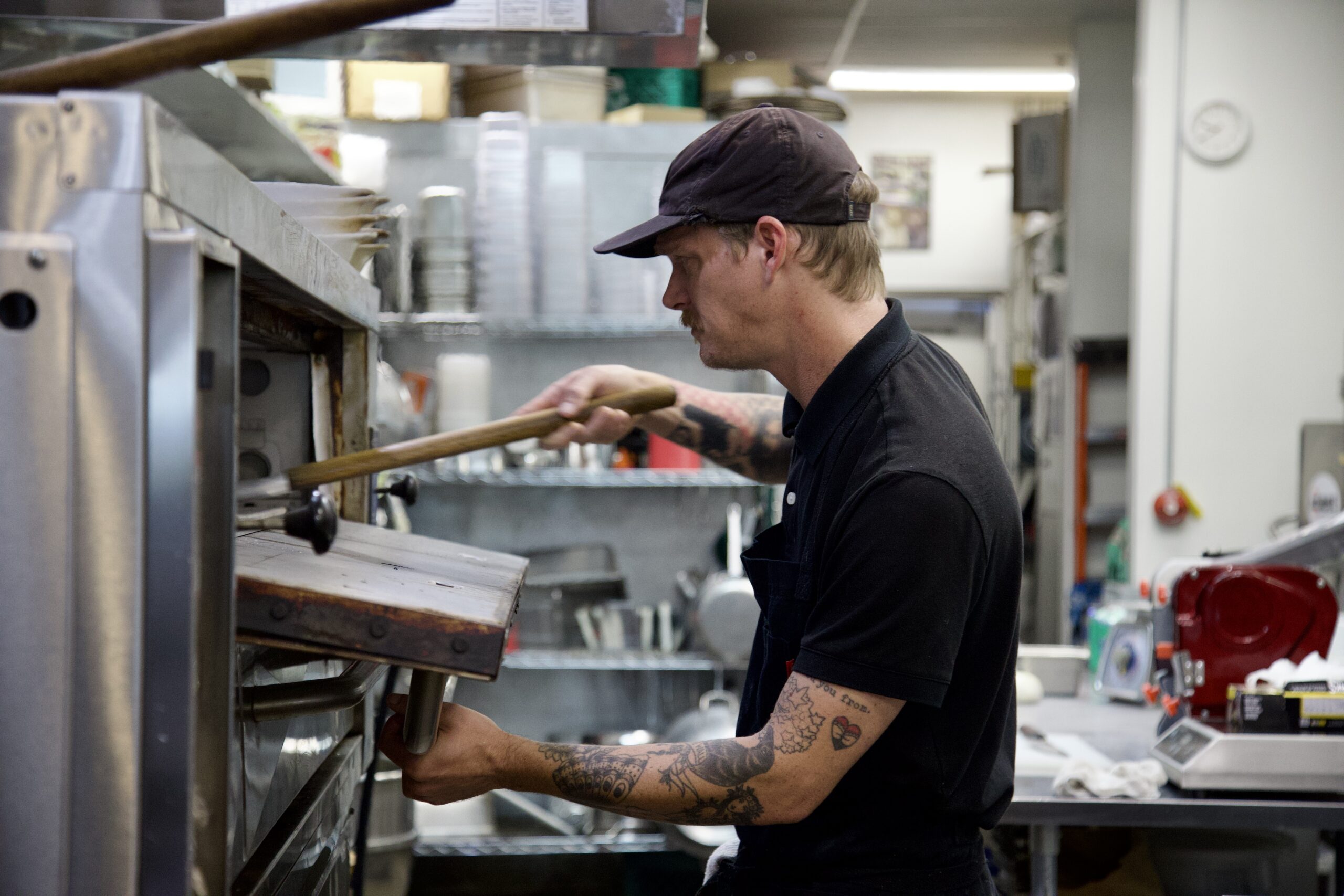
If you’ve ever been to a Gastronomic Union of Tucson (GUT) Collaborative Pop-Up Dinner, then you know how exciting and fun they can be. The anticipation of that first course. The buzz emanates from the kitchen where a cadre of local chefs prep each course. The awe when a beautiful plate of food is placed graciously in front of you, often by one of the chefs. The lively conversation fills the air. And the knowledge that this is a one-of-a-kind meal, never to be replicated.
The whole evening appears seamless.
But getting to that point takes a lot of thought and effort on the part of a huge team of chefs. Every detail is carefully constructed to make sure diners (and to be honest, the chefs involved) have a wonderful experience.
GUT is a “collaboration of over 30 local chefs and food professionals” who “following Tucson’s designation by UNESCO as a World City of Gastronomy, came together to foster a culinary community of creativity, professional development, and community engagement.”
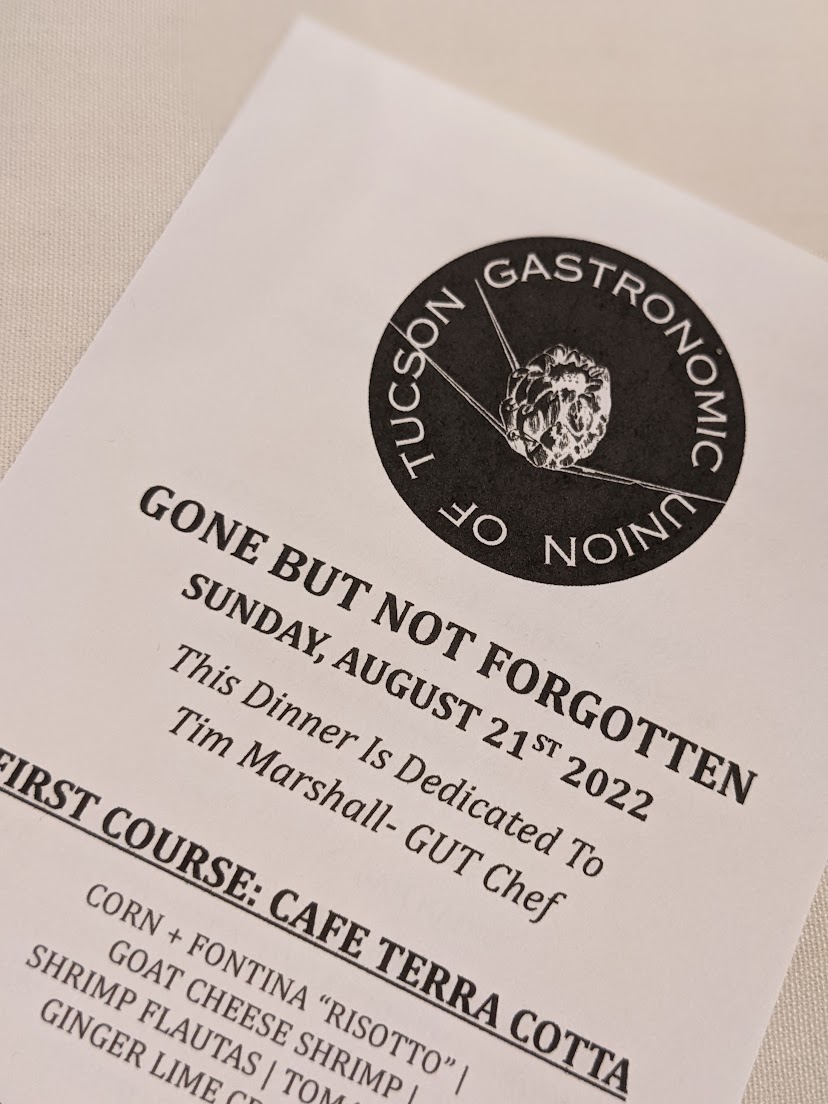
The dinner featured here is the second of the 2022 season. “Gone, But Not Forgotten” was held at the Mountain Oyster Club on Sunday, August 21, celebrating five popular restaurants from Tucson’s past. Once the invite was posted, the dinner sold out in 15 minutes.
The dinner was also dedicated to Tim Marshall from The Parish, who died unexpectedly a few days before. He was a dedicated chef, a friend to all, and a brother to Mat Cable. He may be gone, but he will never be forgotten.
On an evening about a month before the dinner, the GUT board called for a meeting at Danny’s Baboquivari bar in midtown. In attendance were GUT’s Board Members:
Also in attendance were the four captains who led each team in a chosen course from a preselected restaurant of their choice:
Cable is the fifth captain in the five-course dinner.
Captains volunteer for the position but Cable notes in a text message after the meeting, “We don’t allow just anyone to be captain. Most of the time they need to have been on a team before so they know how it works. There are a lot of moving parts. It would be difficult to lead a course if someone hadn’t been through the process before.”
The conversation is light, most of these guys have known one another for years and are friends as well as colleagues. But there is a seriousness to what’s happening here. Everyone wants this to be a memorable experience.
The first item on the agenda is who will take which course and what restaurants will be chosen. Café Terra Cotta (DiGrazia) and The Tack Room (Hickey) are a must, while other names are tossed about and the three other chefs say they’ll have their decision soon.
Then comes “The Draft” — the process of choosing teams from a list of available chefs. If a chef wants to be involved, they can sign up on the GUT private Facebook page or talk to Cable, chef Obie, or Sanner. To be fair, straws are drawn to determine the order of selected team members. Jay goes first, Cable is last. Each chef gets five choices, but if they feel they don’t need that many, they can opt out.
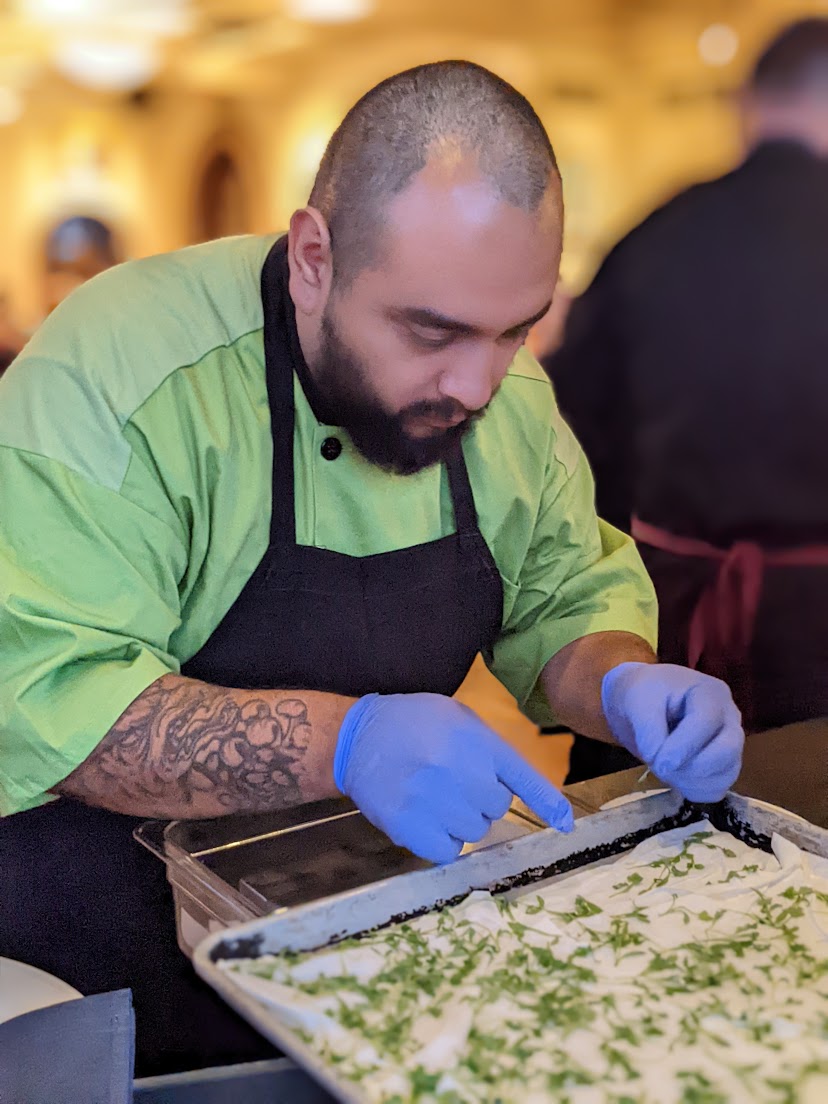
The process moves quickly. The choices are based on a number of reasons: a certain chef’s strengths, a chance to work with an old friend, and a chance to work with someone new. Within 20 minutes, each chef has their team in place.
The date is fast approaching so Sanner sets deadlines for each step of the process. The chefs needed to have the specific restaurant and a general idea of their dish by the following Wednesday, August 3.
By Wednesday, August 10, each team’s dish needed to be tested. That day was also the deadline to inform chef Obie what and how much of each ingredient they’ll need and the type of plates they’ll use. These don’t end up being hard and fast, but chefs being chefs, everything falls into place with time to spare.
The meeting breaks up shortly after and most of the chefs have to get to work for dinner service.
The weeks following are filled with a slew of messages between the captains and their team members. Ideas are tossed around, suggestions are made, and questions are asked and answered. The whole idea is to take an iconic dish and add a “GUT twist.” This leads to some creative results.
Getting a team of chefs together to work out dishes can be tough because of their conflicting schedules. Even securing a kitchen can pose an issue as most kitchens are busy all day, every day. But the chefs persist and the dinner begins to take shape.
Captains DiGrazia and Garcia share photos of completed plates, chef Wendy Gauthier is working on a side for Cable’s team. Chef Stoller draws pictures of each of her three desserts The drawings were beautiful and the following day she posts a pic of the Café Terra Cotta-inspired dessert. Chef Susan Tomber Fulton from Gourmet Girls presents a gluten-free pastry “bun” created for consideration in the third course.
Cable makes an executive decision regarding his dish: the cheesesteak will be deconstructed. The team agrees that this elevates the dish and highlights the flavors of the beef. Although there is a basic idea of what the dish will be, there is still a lot of discussion on how to pull it all together: What sauces will be used, and how much of each? How should we cut and present the beef? Are we including tomatoes? Mushrooms? Onions? Where should each element be placed?
The meeting ends and the chefs head to the kitchen for a trial run. While the final edition may have another type of beef or a bit of decoration, they finalize what they will be serving.
Next, Sanner puts out a call for SUCCINT (his caps not mine) menu descriptions in order to get the guest menus printed. The texting continues until practically the last minute on Sunday, August 21.
The staid sitting room at the Mountain Oyster Club gives no hint as to what is going on in the kitchen just yards away.
The dining room manager is giving a short lesson to the servers on the proper way to serve — from the right. Then, many of whom are the chefs, head to the kitchen once the lesson is over. The front of house team, led by Megan Marcello Noli, puts the final touches on the dining room.
There, it’s a bumper-to-bumper traffic jam of chefs working at a frantic pace, but there’s purpose and anticipation for what will happen in the next three hours. I slip quietly slip out of the kitchen. This is no place for a fumbling writer.

Fellow writer and Tucson Foodie alum, Edie Jarolim, and I find a table near the long prep tables so that diners get front-row seats to the plating process. The dining room is gorgeous with huge windows allowing for stunning views of the Catalinas. A menu for the evening sits at each place setting.
As the crowd enters, we chat with our table mates, two foodie-friendly couples, whose names I didn’t write down, but they were fun people. Sometimes sitting at a table with strangers can be intimidating — not here at a GUT dinner.
We enjoy the opening cocktail — jalapeño vodka — and chat about the restaurants that will be featured. Diners will have the choice of white or red wine during dinner.
In his famous booming voice, Chef Obie calls for everyone’s attention and the crowd quickly quiets. He welcomes us and gives a brief outline of the dinner, a short and humorous history of GUT, and then introduces the first chef. Chef Obie introduces each chef as the evening progresses.
Chef DiGrazia gives details of the dish noting, “I just wanted to make the stuff I made when I worked there.”
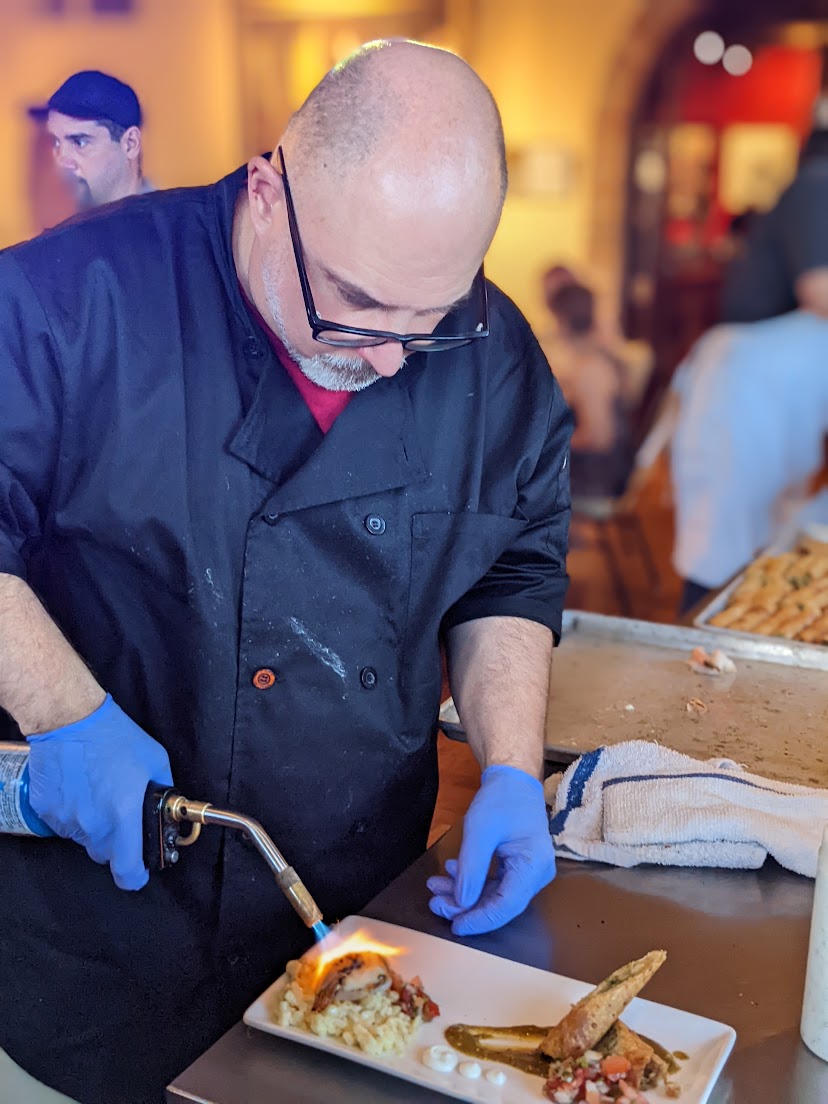
An assembly line of chefs is formed and each element of the dish is plated with Rocco adding the last step a quick firing of the shrimp.
As each dish is plated, runners grab two or three, and then under the cool guidance of the dining room manager take them to a table. They are gracefully placed in front of the diners. More than 80 dishes are on the tables in a matter of minutes.
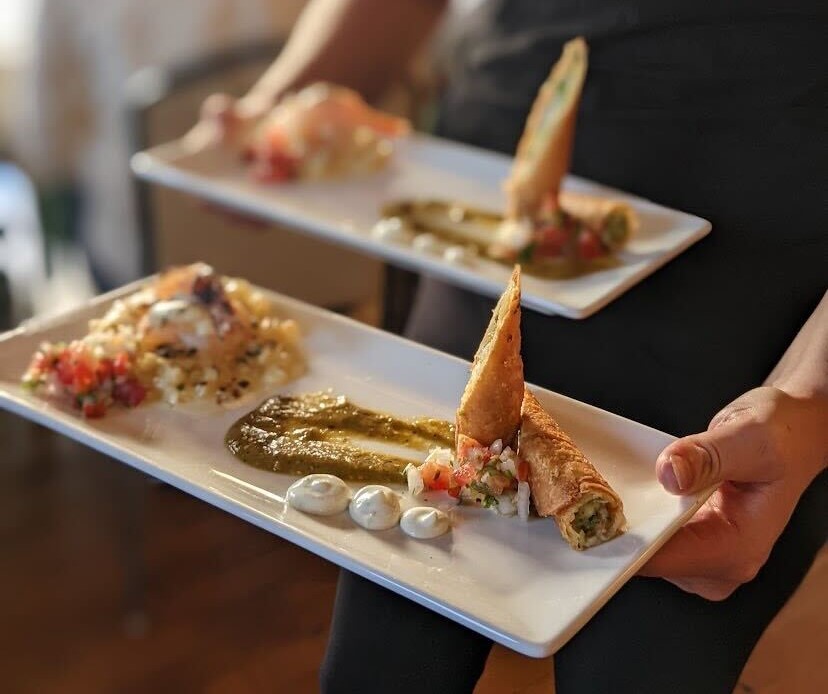
The stuffed shrimp is sublime, taking me back to the dish that was served at Terra Cotta. The only thing missing was three or four more. The flautas were crisped perfectly and the lime cream took them to another level. And that corn risotto? Lick-the-plate good.
The empty plates are whisked away just as the second round of items are brought into the dining room.
In his intro, chef Garcia explains that El Indio was known for its soups and he wanted to “kick up a tradition.” With his soup, he did just that. This definitely wasn’t your nana’s caldo.
Instead of all the vegetables swimming in the broth, here they stand at the side, which helps them retain their textures, The flavors popped, especially the potato puree. The first spoonful held just a hint of heat but then that gave way to the rich consommé. The toile was the subject of much of the conversation at the table.
Third Course
That last little bit is a play on the original Greasy Tony’s menu where there was “no extra charge for the grease.” The only thing that recognizable piece of this kicked-up version of Greasy Tony’s popular dish would be the tiny New Jersey flag placed on top. The beef was as tender as possible and substituting the caciocavallo for provolone was genius. The brioche, which had been a big topic of conversation during planning, was golden brown and toasty.
Chef Tony would certainly have loved the ‘cheesesteak’ and been honored to be included in the evening’s festivities.
Chef Hickey wanted to honor fellow chef Obie with this course. As he explained in his introduction, he modeled this dish after one of the courses in Obie’s last three-course dinner at The Tack Room.
The changes were outstanding. No steak and lobster here. Instead, thin, tender lamb loin was wrapped around a creamy mousse. The sweet green pea puree was the perfect complement to the savory lamb jus, and the contrasting colors were like Jackson Pollack on a plate.
Any of these treats would have been a fantastic finish to the wonderful dinner but chef Stoller really wanted to do all three as a complement to the rest of the dishes.
The Orange Dream Baked Alaska was a wonder from the first spoonful, the mandarin sherbet a chilled surprise. The “pie” was creamy with a crunch from the crumbled cookie and it wasn’t ultra-sweet even though there were plenty of sweet elements. The Apple Churrito Burrito was like a mini apple pie but oh so crunchier.
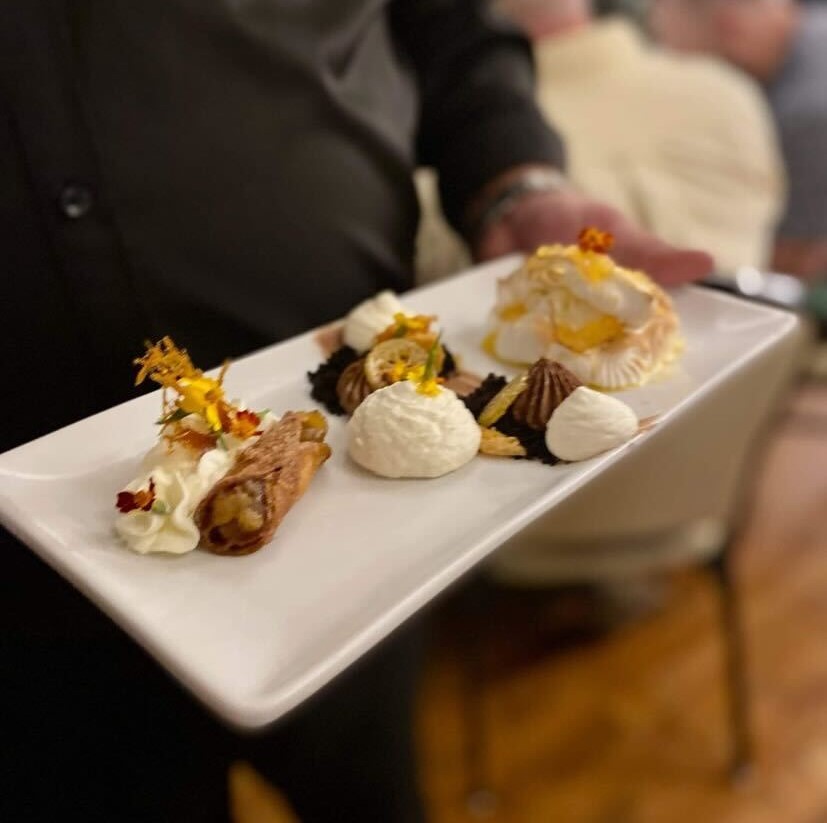
This was a spectacular meal from beginning to end. The setting, the company, the wonderful memories of all those restaurants, and of course, the service and food.
As a most important note, all the chefs wanted to praise chef Michael Elefante from Mama Louisa’s Italian Kitchen. Although he was pretty much invisible through service, chef Elefante “made the service flow” according to chef Obie.
“It was the first time we had a chef focused on plating and service,” said chef Obie. “He met with the captains, took notes on their dishes, helped them figure out efficient plating, recruited all extra hands for plating and serving ahead of time, and made sure teams were staged and ready to execute as soon as the previous course was cleared. He really knocked it out of the park.”
The entire kitchen crew consisted of more than 30 people from restaurants all over town. All types of restaurants; from a simple food cart to a high-end private club. Young chefs, seasoned chefs, long-time locals, newcomers, men, and women. It was an eclectic mix supporting one another in their profession.
Everyone there — both back and front of the house — put out their best work with passion and precision. It’s all because they share a love for Tucson and what the evening was all about. It’s rare and should be shared and treasured.
The next experience is on Sunday, September 18. The theme is “Right Here, Right Now” and will highlight the best, seasonal ingredients farmed and foraged in the Tucson Basin.
GUT will announce the ticket sales on their social media pages before they go live on eventbrite.com.
Rita Connelly is the author of “Lost Restaurants of Tucson,” “Historic Restaurants of Tucson,” and “Arizona Chimichangas,”all published by The History Press. Growing up in a large Italian family instilled in her an appreciation for the important role food plays...